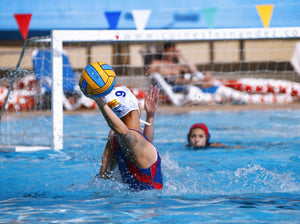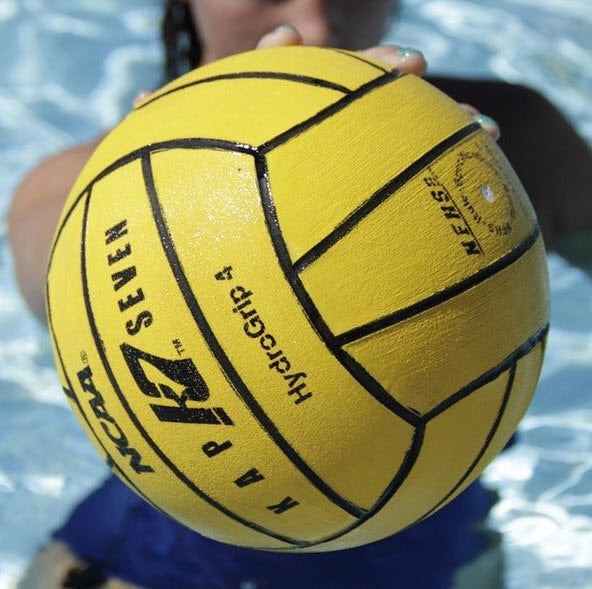Understanding Defense in Water Polo

Offense sells tickets, defense wins games! The old adage is true: solid defense is a key to winning games. On defense, players work to regain possession of the ball and prevent a goal in their own net. The defense attempts to knock away or steal the ball from the offense, or commit a foul in order to stop an offensive player from taking a shot on goal. To do so, the defender attempts to stay between the attacker and the goal and maintain inside water at all times.
In this guide, you’ll learn the two basic defensive formations and where players are positioned relative to their offensive positions, the importance of inside water, and how intentional fouls play a big part in the defense winning the ball back.
A good defensive game is just as important, if not more so, than a good offensive game. Teams spend significant amounts of time adjusting their defensive strategies according to the teams they are up against, but ultimately they must rely on the foundations of a solid defense to pull through.
Defensive Formations
When positioning yourself or your team for defense, there are two basic defensive strategies you should be familiar with:
Man to man
Man to man defense is used for high pressure situations. You may be leading late in a game, trying to protect a one goal lead. It may be a tie game and your team is desperate for the leg up. Either way, this type of defense does not allow any wiggle room for the offense. You need to stay on your offender like glue! If he drives, you drive with them, but make sure to communicate with your teammates if you see a screen taking place between your assigned offensive players. At that point it may be necessary to call “switch,” and swap defensive assignments. Remember to always maintain inside water positioning.
Zone
Zone defense is used for lower-key game situations. Typically, a team will put their most explosive player in the hole set position, therefore leaving their weaker players to play the perimeter positions. In this kind of situation, the perimeter defense will position themselves around the five offensive perimeter positions, but slough off them a bit in order to keep an extra eye on the offensive team’s hole set and help out when needed. Each defender is assigned a zone to defend, and each of these zones corresponds to an offensive position. Whichever offensive players drive in and out of your zone, you are responsible for maintaining good defensive positioning.
In a zone defense, all the defenders are defending the zone and not the player. Except for the hole defender, that is. The hole defender is assigned to the hole set and always plays man-to-man, because, left without solid defense, the hole set will score every time.
Shifting Focus
Like offensive positioning, defensive positioning never allows players any idle time. The players and zones that each player defends are never the same throughout the course of a game. Offensive players are constantly moving and if you’re on man to man defense, defenders will move with them. Even in a zone defense, offensive players will swim back and forth many times, so it’s important to move with the players that fall within your zone. Typically, offensive teams will set up in either a 3-3 or umbrella formation, so that when teams swim back to defense, their defensive positions are similar to their offensive positions, just shifted slightly.
- Point position on offense is usually the same person that plays hole defender, putting him at the top of the formation on offense, but the bottom on defense.
- The wings and drivers on offense are the same players that defend outside water or perimeter players on defense.
- The hole set usually guards at the top of the formation on defense, putting him at the bottom of the formation on offense, and closest to the goal.
Inside Water
A defender’s primary job is to stay between the offensive player and the net. When a defender has this optimal position, it is called having inside water. The more the defense allows the offense inside water, the lesser their chances are to prevent goals. Think about it: If there isn’t a defender between the offender and the goal, what’s stopping the offensive player from taking a straight power shot at the net? This is why the first rule of defensive play is to always maintain inside water. If you don’t have inside water, you have nothing.
Intentional Fouls
Water polo is a physical game, so expect to be jostled around a bit. Many players (especially at higher levels of play) will get away with kicking and pulling their opponents under water, out of sight of the referees. However there are rules and limitations as to what kind of rough-housing the referee will allow. The most common minor fouls are constantly called against players who hold, block, or pull other players away from the ball. Fouls are not called towards the advantage of a player holding or touching the ball.
Intentional fouls are often made in order to give the defense a leg up, like when the hole defender is in need of assistance, or to slow down the clock. The hole defender may often intentionally foul the hole set in order to prevent a scoring attack. When a minor foul is made in front of the goal, whether it is a perimeter player or the hole, referees often grant a free pass. In this situation, it benefits the defending team to foul the hole set because having the ball in the hands of a perimeter player’s hands is a lesser threat.
When perimeter defensive players perform intentional fouls, they’ll slough off their offender, move toward the goal and double team the hole set, and if they move quickly enough, possibly steal the inbound pass. The referee may refrain from declaring a foul, if in his judgment this would give the advantage to the offensive team. This is known as the Advantage Rule.
Practice Makes Perfect
Now that you have the basic knowledge of defensive positioning, it’s time to round up some friends and put this new knowledge to practice! In a team environment it’s important to read each other’s signals and communicate. Now that you know the defensive formations, the proper positioning, the importance of staying between the goal and the offense at all times, and the reasons to commit a foul for your team’s benefit, you’re ready to try it in the pool.



